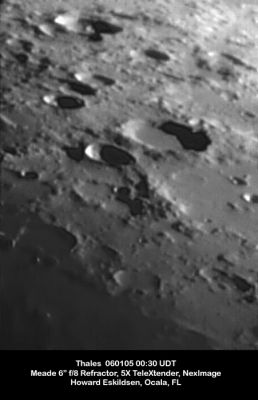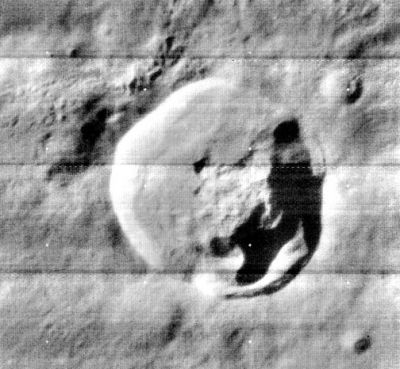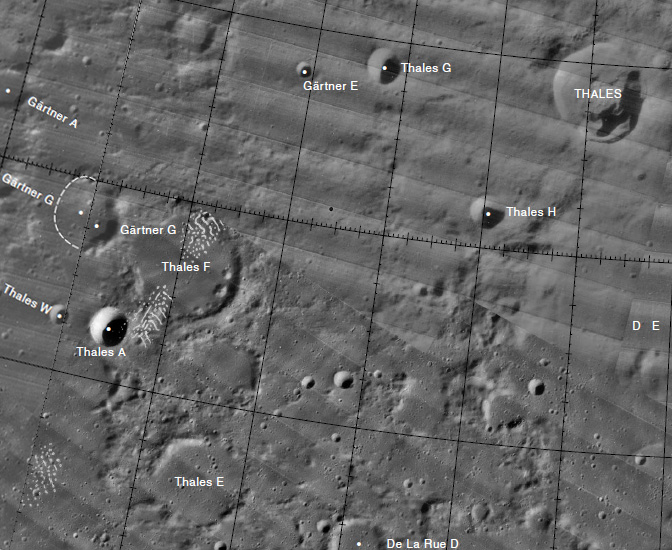Difference between revisions of "Thales"
(Created page with "<div id="content_view" class="wiki" style="display: block"> =Thales (and Strabo east of it)= {| class="wiki_table" | Lat: 61.73°N, Long: 50.28°E, Diam: 30.75 km, Depth:...") |
|||
| (2 intermediate revisions by the same user not shown) | |||
| Line 3: | Line 3: | ||
{| class="wiki_table" | {| class="wiki_table" | ||
| | | | ||
| − | Lat: 61.73°N, Long: 50.28°E, Diam: 30.75 km, Depth: 3.2 km, [http://the-moon. | + | Lat: 61.73°N, Long: 50.28°E, Diam: 30.75 km, Depth: 3.2 km, [http://the-moon.us/wiki/R%C3%BCkl%206 Rükl: 6], [http://the-moon.us/wiki/Stratigraphy Copernican]<br /> |
|} | |} | ||
| − | [http://www.lpod.org/coppermine/displayimage.php?pid=1303&fullsize=1 [[Image: | + | [http://www.lpod.org/coppermine/displayimage.php?pid=1303&fullsize=1 [[Image:Normal_Thales060105.jpg|external image normal_Thales060105.jpg]]][http://www.lpod.org/coppermine/displayimage.php?pid=1563&fullsize=1 [[Image:Normal_Thales-LO4-080-h1.jpg|external image normal_Thales-LO4-080-h1.jpg]]]<br /> '''Left:''' ''[http://lpod.org/coppermine/displayimage.php?pos=-1303 Howard Eskildsen]'', '''Thales''' is the smaller one of the two craters in the center of the image. The larger companion is [http://the-moon.us/wiki/Strabo Strabo].<br /> '''Right:''' ''[http://lpod.org/coppermine/displayimage.php?pos=-1563 LO4-080-h1]''<br /> <br /> <div id="toc"> |
| − | + | ||
| − | |||
==Images== | ==Images== | ||
[http://www.lpod.org/coppermine/thumbnails.php?album=search&type=full&search=Thales LPOD Photo Gallery] [http://www.lpi.usra.edu/resources/lunar_orbiter/bin/srch_nam.shtml?Thales%7C0 Lunar Orbiter Images]<br /> <br /> | [http://www.lpod.org/coppermine/thumbnails.php?album=search&type=full&search=Thales LPOD Photo Gallery] [http://www.lpi.usra.edu/resources/lunar_orbiter/bin/srch_nam.shtml?Thales%7C0 Lunar Orbiter Images]<br /> <br /> | ||
==Maps== | ==Maps== | ||
| − | ''([http://the-moon. | + | ''([http://the-moon.us/wiki/LAC%20zone LAC zone] 14A2)'' [http://planetarynames.wr.usgs.gov/images/Lunar/lac_14.pdf USGS Digital Atlas PDF]<br /> <br /> |
==Description== | ==Description== | ||
<br /> | <br /> | ||
===Elger=== | ===Elger=== | ||
| − | ''([http://the-moon. | + | ''([http://the-moon.us/wiki/IAU%20directions IAU Directions])'' THALES.--A bright formation, also associated with the N. side of [http://the-moon.us/wiki/De%20la%20Rue De la Rue], adjoining [http://the-moon.us/wiki/Strabo Strabo] on the N.W. Schmidt shows a minute hill in the interior.<br /> <br /> |
===Wikipedia=== | ===Wikipedia=== | ||
[http://en.wikipedia.org/wiki/Thales_%28crater%29 Thales]<br /> <br /> | [http://en.wikipedia.org/wiki/Thales_%28crater%29 Thales]<br /> <br /> | ||
==Additional Information== | ==Additional Information== | ||
* IAU page: [http://planetarynames.wr.usgs.gov/Feature/5945 Thales] | * IAU page: [http://planetarynames.wr.usgs.gov/Feature/5945 Thales] | ||
| − | * Depth data from [http://the-moon. | + | * Depth data from [http://the-moon.us/wiki/Kurt%20Fisher%20Crater%20Depths Kurt Fisher database] |
** Westfall, 2000: 4.54 km | ** Westfall, 2000: 4.54 km | ||
** Cherrington, 1969: 1.79 km | ** Cherrington, 1969: 1.79 km | ||
* Measures on LRO QuickMap give depth about 3.2 km | * Measures on LRO QuickMap give depth about 3.2 km | ||
* Measures on LRO QuickMap give central peak height about 310 m | * Measures on LRO QuickMap give central peak height about 310 m | ||
| − | * Included in [http://the-moon. | + | * Included in [http://the-moon.us/wiki/ALPO%20list%20of%20bright%20ray%20craters ALPO list of bright ray craters] |
| − | * Edward Emerson Barnard at Lick found the bowl of '''Thales''' filled with pale luminous haze one night in 1892. Source: V.A.Firsoff's ''The Old Moon and the New'' (1969), page 183.<span class="membersnap">- | + | * Edward Emerson Barnard at Lick found the bowl of '''Thales''' filled with pale luminous haze one night in 1892. Source: V.A.Firsoff's ''The Old Moon and the New'' (1969), page 183.<span class="membersnap">- DannyCaes <small>May 19, 2012</small></span> |
| − | * The same phenomenon (E.E.Barnard's 1892 observation of pale luminous haze in '''Thales''') is also mentioned in Patrick Moore's ''New Guide to the Moon'' (1976), page 202.<span class="membersnap">- | + | * The same phenomenon (E.E.Barnard's 1892 observation of pale luminous haze in '''Thales''') is also mentioned in Patrick Moore's ''New Guide to the Moon'' (1976), page 202.<span class="membersnap">- DannyCaes <small>May 19, 2012</small></span> |
<br /> | <br /> | ||
==Nomenclature== | ==Nomenclature== | ||
| − | - [http://en.wikipedia.org/wiki/Thales Thales of Miletos] (ca. 624 BC – ca. 546 BC) was a pre-Socratic Greek mathematician, astronomer and philosopher and one of the Seven Sages of Greece. Many regard him as the first philosopher in the Greek tradition as well as the "father of science".<br /> - '''de Ulloa''' (plate [http://gallica.bnf.fr/ark:/12148/btv1b2600117x.item.f68.langEN T. LXXIII]) (name first used by Van Langren). This formation is limbward of Schröter's "'''Thales'''", which in turn appears to be the modern [http://the-moon. | + | - [http://en.wikipedia.org/wiki/Thales Thales of Miletos] (ca. 624 BC – ca. 546 BC) was a pre-Socratic Greek mathematician, astronomer and philosopher and one of the Seven Sages of Greece. Many regard him as the first philosopher in the Greek tradition as well as the "father of science".<br /> - '''de Ulloa''' (plate [http://gallica.bnf.fr/ark:/12148/btv1b2600117x.item.f68.langEN T. LXXIII]) (name first used by Van Langren). This formation is limbward of Schröter's "'''Thales'''", which in turn appears to be the modern [http://the-moon.us/wiki/Strabo Strabo]. Schröter's "'''de Ulloa'''" is most likely [http://en.wikipedia.org/wiki/Antonio_de_Ulloa Antonio de Ulloa] (1716–1795) who participated in the French expedition to Ecuador to measure the length of an arc of the terrestrial meridian. Van Langren's "de Ulloa" might possibly be [http://en.wikipedia.org/wiki/Francisco_de_Ulloa Francisco de Ulloa] an earlier Spanish explorer. Research Jim Mosher and Danny Caes<br /> <br /> |
==The Bessel Ray (is Thales the source?)== | ==The Bessel Ray (is Thales the source?)== | ||
| − | The ''21st Century Atlas of the Moon'' (Charles A. Wood/ Maurice J.S. Collins) is perhaps the very first lunar atlas which has a name for the mysterious high-albedo ray running across '''Mare Serenitatis''' and crater '''Bessel'''. This ray is one of the most stubborn riddles in the history of moon observing and selenography.<br /> What is the source of this remarkable singular ray of ejecta? Is '''Bessel''' the source? Or is it perhaps crater '''Thales''' to the north of '''Mare Serenitatis'''? Or perhaps crater '''Menelaus''' at the southern rim of '''Mare Serenitatis'''?<br /> It's very strange that this kind of pronounced rays (ejecta rays from impact craters) don't have official IAU names.<br /> Anyway, Chart 11 (page 35) in the ''21st Century Atlas of the Moon'' shows the informal name '''''Bessel Ray''''' just north of crater '''Bessel'''.<br /> How many (ancient or recent) moonbooks have a description of the mysterious '''''Bessel Ray''''' in '''Mare Serenitatis'''?<br /> <span class="membersnap">- | + | The ''21st Century Atlas of the Moon'' (Charles A. Wood/ Maurice J.S. Collins) is perhaps the very first lunar atlas which has a name for the mysterious high-albedo ray running across '''Mare Serenitatis''' and crater '''Bessel'''. This ray is one of the most stubborn riddles in the history of moon observing and selenography.<br /> What is the source of this remarkable singular ray of ejecta? Is '''Bessel''' the source? Or is it perhaps crater '''Thales''' to the north of '''Mare Serenitatis'''? Or perhaps crater '''Menelaus''' at the southern rim of '''Mare Serenitatis'''?<br /> It's very strange that this kind of pronounced rays (ejecta rays from impact craters) don't have official IAU names.<br /> Anyway, Chart 11 (page 35) in the ''21st Century Atlas of the Moon'' shows the informal name '''''Bessel Ray''''' just north of crater '''Bessel'''.<br /> How many (ancient or recent) moonbooks have a description of the mysterious '''''Bessel Ray''''' in '''Mare Serenitatis'''?<br /> <span class="membersnap">- DannyCaes <small>Aug 16, 2015</small></span><br /> <br /> |
==LROC Articles== | ==LROC Articles== | ||
| Line 39: | Line 38: | ||
==LPOD Articles== | ==LPOD Articles== | ||
| − | * [http:// | + | * [http://www2.lpod.org/wiki/March_21,_2007 Radiant Rays] |
<br /> | <br /> | ||
==Lettered craters== | ==Lettered craters== | ||
| − | [[Image: | + | [[Image:Thales-letter.jpg|thales-letter.jpg]]<br /> Graphic LAC [http://planetarynames.wr.usgs.gov/images/Lunar/lac_14_lo.pdf No. 14]. Excerpt from the ''[http://planetarynames.wr.usgs.gov/dAtlas.html USGS Digital Atlas of the Moon].''<br /> <br /> |
==Bibliography== | ==Bibliography== | ||
<br /> <br /> | <br /> <br /> | ||
---- | ---- | ||
| − | [http://the-moon. | + | [http://the-moon.us/wiki/Alphabetical%20Index Named Features] -- Prev: [http://the-moon.us/wiki/Dorsa%20Tetyaev Dorsa Tetyaev] -- Next: [http://the-moon.us/wiki/Theaetetus Theaetetus]<br /> |
---- | ---- | ||
| − | + | </div> | |
Latest revision as of 02:19, 16 April 2018
Contents
Thales (and Strabo east of it)
|
Lat: 61.73°N, Long: 50.28°E, Diam: 30.75 km, Depth: 3.2 km, Rükl: 6, Copernican |


Left: Howard Eskildsen, Thales is the smaller one of the two craters in the center of the image. The larger companion is Strabo.
Right: LO4-080-h1
Images
LPOD Photo Gallery Lunar Orbiter Images
Maps
(LAC zone 14A2) USGS Digital Atlas PDF
Description
Elger
(IAU Directions) THALES.--A bright formation, also associated with the N. side of De la Rue, adjoining Strabo on the N.W. Schmidt shows a minute hill in the interior.
Wikipedia
Additional Information
- IAU page: Thales
- Depth data from Kurt Fisher database
- Westfall, 2000: 4.54 km
- Cherrington, 1969: 1.79 km
- Measures on LRO QuickMap give depth about 3.2 km
- Measures on LRO QuickMap give central peak height about 310 m
- Included in ALPO list of bright ray craters
- Edward Emerson Barnard at Lick found the bowl of Thales filled with pale luminous haze one night in 1892. Source: V.A.Firsoff's The Old Moon and the New (1969), page 183.- DannyCaes May 19, 2012
- The same phenomenon (E.E.Barnard's 1892 observation of pale luminous haze in Thales) is also mentioned in Patrick Moore's New Guide to the Moon (1976), page 202.- DannyCaes May 19, 2012
Nomenclature
- Thales of Miletos (ca. 624 BC – ca. 546 BC) was a pre-Socratic Greek mathematician, astronomer and philosopher and one of the Seven Sages of Greece. Many regard him as the first philosopher in the Greek tradition as well as the "father of science".
- de Ulloa (plate T. LXXIII) (name first used by Van Langren). This formation is limbward of Schröter's "Thales", which in turn appears to be the modern Strabo. Schröter's "de Ulloa" is most likely Antonio de Ulloa (1716–1795) who participated in the French expedition to Ecuador to measure the length of an arc of the terrestrial meridian. Van Langren's "de Ulloa" might possibly be Francisco de Ulloa an earlier Spanish explorer. Research Jim Mosher and Danny Caes
The Bessel Ray (is Thales the source?)
The 21st Century Atlas of the Moon (Charles A. Wood/ Maurice J.S. Collins) is perhaps the very first lunar atlas which has a name for the mysterious high-albedo ray running across Mare Serenitatis and crater Bessel. This ray is one of the most stubborn riddles in the history of moon observing and selenography.
What is the source of this remarkable singular ray of ejecta? Is Bessel the source? Or is it perhaps crater Thales to the north of Mare Serenitatis? Or perhaps crater Menelaus at the southern rim of Mare Serenitatis?
It's very strange that this kind of pronounced rays (ejecta rays from impact craters) don't have official IAU names.
Anyway, Chart 11 (page 35) in the 21st Century Atlas of the Moon shows the informal name Bessel Ray just north of crater Bessel.
How many (ancient or recent) moonbooks have a description of the mysterious Bessel Ray in Mare Serenitatis?
- DannyCaes Aug 16, 2015
LROC Articles
LPOD Articles
Lettered craters

Graphic LAC No. 14. Excerpt from the USGS Digital Atlas of the Moon.
Bibliography
Named Features -- Prev: Dorsa Tetyaev -- Next: Theaetetus